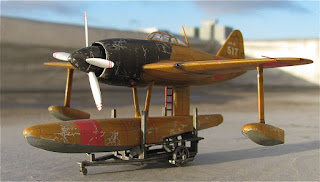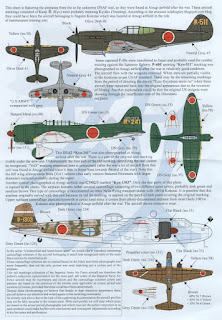Included in the recent bumper crop of new releases from Rising Decals is this splendid 1/72 scale sheet for the good looking IJN twin. The lineage of the units operating this fast bomber is almost as complex as that of the Army's Ki-46 units and Rising offer a selection of seven schemes for the P1Y1 in some of the better known units. Designed for the excellent Hasegawa kit the decals are no doubt adaptable to the older Revell-Takara kit, of which more here in due course. Of special note are the over painted and weathered hinomaru borders, very well represented on sheet RD72095 which offers the following subjects:-
- 鵬-71 (Ohtori-07) of 521 Ku - the first unit to operate Ginga following activation at Toyohashi on 20 Aug 1943, and as with all other subjects on this sheet depicted in dark green over natural metal finish. Originally 521 Ku consisted of 24 Ginga and 24 Suisei dive bombers but in November the Suisei were moved out to form 523 Ku and 521's official complement was first increased to 48 Ginga and then in Feb 1944 to 96 Ginga. The unit was under the command of Cdr Shigeki Negoro but the Hikotai leader was the notable Lt Cdr Takashige Egusa, 'God of Dive Bombing'. The unit worked up through various technical development issues and moved to Guam during April and May 1944 where training continued. After several losses in accidents and during search operations the unit was committed to offensive operations over the Marianas, with Lt Cdr Egusa killed in its first attack against USN vessels on 15 Jun 1944 when all eight participating Ginga were shot down. Capt Yoshio Kamei who had replaced Negoro as unit commander was also killed in action and the unit was disbanded on 10 July 1944, the surviving personnel and aircraft being incorporated into Hikotai K-406 (see below).
- 22-203 of 522 Ku -the second unit formed on Ginga, at Kisarazu on 15 Jun 1944 with an initial complement of 96 aircraft reduced to 48. The unit was engaged only in search sorties until disbandment on 10 Jul 1944.
- 顕762-07 (Akira 762-07) of 501 Hikotai, 762 Ku at Oita, Japan in Feb 1945 - this aircraft is equipped with H-6 radar. The 501st were established within Yoko Ku on 10 Jul 1944 with a complement of 48 Ginga and from Sept were incorporated within 752 Ku for operations off Taiwan where it suffered heavy losses. From November it was incorporated in 762 Ku ( a former Rikko unit) and fought over the Philippines, with a detachment of special attack (suicide) aircraft formed as Shippu-tai, the first Ginga suicide unit (see also below). The unit operated against Saipan and Iwo Jima from Katori and from Kanoya in late Jan 1945 before moving to Miyazaki with a detachment at Miho for sorties over Okinawa. During operations from Jul 1944 to Mar 1945 a succession of three Hikotai leaders were killed in action.
- 762-23 of 762 Ku at Atsugi, Japan, in Aug 1945 - this aircraft has a large white kanji character 'gaku' (學 meaning learning, knowledge or school) painted within the fuselage hinomaru, possibly representing an aircraft used for training of some type.
- 763-62 of 763 Ku at Yontan, Okinawa post-war - this unit was formed at Izumi on 10 Oct 1944 from Hikotai K-405 (from 524 Ku and subsequently 762 Ku) and K-406 (organised with 44 aircraft and crew from the disbanded 522 Ku) . It fought mainly in the Philippines where it lost most of its strength. The surviving K-405 personnel were incorporated into a 'new' K-406 within 752 Ku in Nov 1944 and after transfer to 701 Ku in Jan 1945 the Hikotai was incorporated within 762 Ku, conducting operations from Izumi and Mito until disbandment on 5 Jun 1945.
- 762-24 of the Asuza Tokubetsu Kougekitai, 762 Ku in March 1945 - the aircraft of suicide volunteer WO Masaru Ochiai who flew one of 24 Ginga in a long range, one-way sortie against the Ulithi anchorage on 11 Mar 1945, planned as Operation 'Tan'. Ochiai applied an epithet in kanji to the fuselage of his aircraft before embarking on the mission which is included on the decal sheet and clearly printed. The force was led by Lt Naoto Kuromaru, the youngest Hikotai leader from the dive-bombing buntai K-262 and included aircraft and crews from K-406. Each Ginga was armed with an 800kg bomb. Two flying boats were to provide navigation but eight Ginga and one of the flying boats turned back or had to force land due to encountering bad weather (as described on the decal sheet). The survivors reached Ulithi but only one flown by Lt Yukinobu Fukuda, was able to strike and damage a ship, the USS Randolph, which was repaired and back in operation from 8 April, whilst another Ginga crash dived onto an illuminated baseball pitch on the islet of Mog Mog. A total of 13 Ginga were lost, six badly damaged and eight out of the ten force-landed crew returned safely.
- 05-221 of 405 Hikotai - see above
This is an excellent, well conceived and well crafted sheet which will enable a number of interesting and important Ginga subjects to be represented. Paints suggested include Gunze 15 IJN Green (Nakajima) for the upper surface of all subjects. The jury is out on whether all Ginga had natural metal under surfaces as Japanese references, older and more recent, vary, with some depicting and describing grey. The NASM example s/n 8923 has a natural aluminium under surface but was manufactured by Nakajima in June 1945 and is configured as a night fighter. The Hasegawa kits major on silver under surfaces throughout. The upper surface green on the NASM survivor was also matched by Robert C Mikesh* to Munsell 5 G 3/1 or Thorpe's N2 (thus closer to IJN D2). In Model Art 458 aircraft 762-15 is depicted in overall dark green. Spinners were usually painted aluminium or dark brown. Interior cockpit colours of the NASM example are varied green hues, from a lighter greyish green, through olive green to the darker black green of some components - not something to sweat about, especially if the canopy of the model is closed up.
With special thanks to Mirek of Rising Decals for the review sheet. Data included in this review on the various Ginga units is drawn from Dr Yasuho Izawa's seminal 'Rikko & Ginga' with acknowledgement and thanks. Bunrindo Co., Ltd., released a 144-page Special Edition FAOW title on the 'Navy Bomber (Ginga)' in 2000 which is well worth seeking out and should help unravel the various airframe and engine configurations of Ginga..
* 'Japanese Aircraft Colors at NASM' by Robert C Mikesh, Asahi Journal Vol.3 No.1 (undated)







































